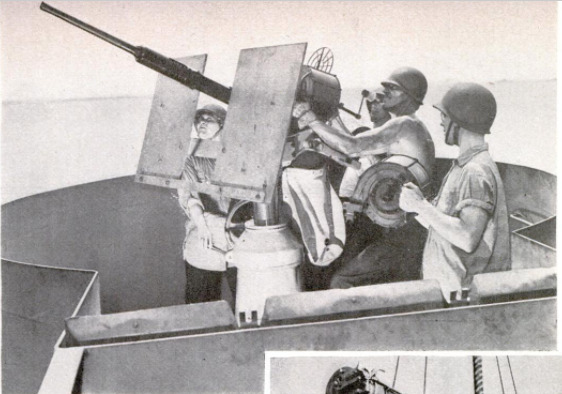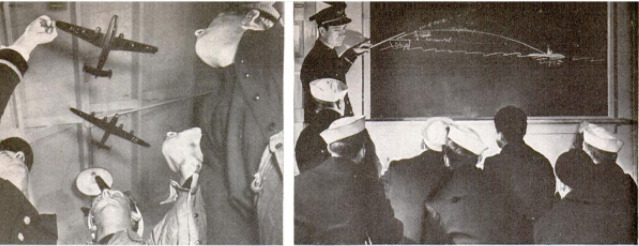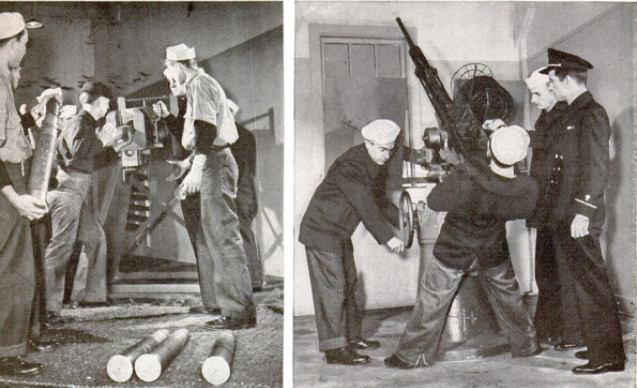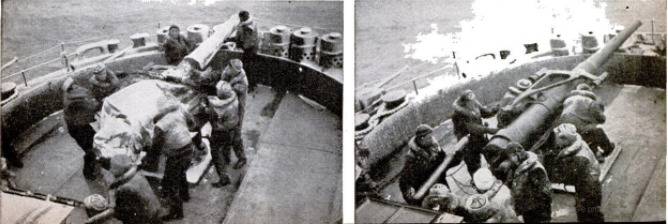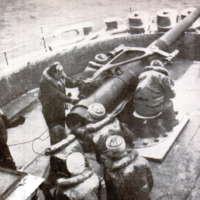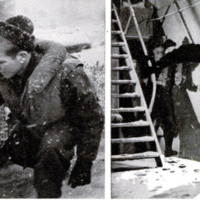-
Titolo
-
U. S. anti-submarine strategies
-
Article Title and/or Image Caption
-
Title: Getting the convoys through
-
Subtitle: Can we break the U-boat strangle hold? Here's how the Navy's Armed Guard is
-
extracted text
-
FOR eight days and nights, the Focke-
wulf Condors have been circling the
convoy, hovering in the horizon clouds tan-
talizingly beyond gunshot. Their mission is
reconnaissance, and they have the patience
of vultures waiting for the kill. Sooner or
later, attack planes are bound to show up,
but no one knows when. The men who man
the guns on the merchant vessels can do
nothing but stand by and wait, taking turns
on lookout, while their ships plough deeper
into the Barents Sea.
On the ninth day, when nerves are frayed
to the snapping point, new signal hoists
flutter up on the Commodore's halyards.
The time for action has come. This is it!
On scores of battered merchantmen,
strung out in columns that stretch from
horizon to horizon, the shattering bells of
the ‘general alarm” sound off. Men bolt
from their quarters and sprint for their
battle stations, lugging their life jackets
with them as they race along gangways and
catwalks. In groups of three they scramble
up elevated turrets forward, aft, and amid-
ships, to man the machine guns. Larger
crews of eight or ten reach the big guns
and break out the heavy ammunition.
Even before the attack planes sweep into
sight, dual-purpose guns are blazing away
on mine sweepers, flak ships, and cruisers
down along the center of the convoy, heav-
ing salvos up at them. A moment later they
crystallize out of the alto-cumulus, end-
less wedge-shaped squadrons of them,
winging straight in from the Nor-
wegian fiords. There are over a hun-
dred planes all told — Messerschmitt
110's, Heinkel 111 K's loaded with tor-
pedoes, dive-bombing Stukas, Junkers
89's. In a minute all hell breaks loose as the
bombers peel off one after another, climb-
ing down the stairs to deposit their lethal
eggs on the ships of the convoy. . ..
This scene was only the curtain-raiser of
a running fight that was to keep up for
many sleepless days on end, straight across
the Arctic waters to the Northern Cape,
then down into the Kola Inlet and right
through to Murmansk. But the crews on
those cargo ships stuck by their guns—
some of them perched atop 500 or more
tons of TNT, knowing that one near miss
would blow them all to Kingdom Come.
Time and again, pink-glowing tracers from
their 20-millimeters arched up into the
blinking fire of a Messerschmitt or Stuka,
and the plane streaked flaming into the sea.
One of their four-inch 50's, firing point-
blank at a conning tower spotted right in
the heart of the convoy, scored a direct hit, |
and all that was left of the sub was a
bubbling froth and a spreading oil slick. An
enemy destroyer, foolhardy enough to dart |
in close, was blown sky-high, while a sister |
ship limped off ablaze. |
Ships were lost, and men too, but—thanks |
largely to these gunners—the greater part
of the convoy got through to Murmansk
port with its trucks and planes and dyna-
mite. The escort cruisers and corvettes did
a magnificient job, but in the last analysis
it’s every merchantmen for himself in these
running battles, and without their gun
crews very few of the cargo ships would
have made it.
Known to the Navy as the Armed Guard,
these men at the guns are an amazing lot.
For all their air of seasoned veterans, most
of them on that convoy were out at sea
for the first time in their lives. Only a few
months before, they had been ordinary
youngsters of 17 or 18, passing their time
in classrooms, on farms, and in shops or
factories. Since the war started, they and
their mates have taken all the enemy had
to offer, not only on the harrowing Mur-
mansk run, but through the Mediterranean
to bomb-pocked Malta, along the Atlantic
routes, and out across the Pacific. Whenever
American supplies are shipped out, the
Armed Guard is to be found aboard, oil-
ing the guns and standing by on the look-
out for trouble.
The Armed Guard is something new
in our fighting forces. Organized in the
summer of 1941, its job was, as the Navy
saw it, to handle the guns that, sooner or
later, would have to be installed on mer-
chant ships to get lend-lease materials safe-
ly to their destinations. But it wasn’t until
November 18, 1941, when the President
signed the Repeal of the Neutrality Act,
that cargo ships began to be fitted out with
guns.
Today, there are thousands of men and
officers in this unique service. What dis-
tinguishes them, besides their extreme
youth, is the circumstance that they are
trained and rushed into their active duty
faster than any other branch of the armed
forces. These men, like all newcomers to
the Navy, must first spend one month at
Boot Camp, getting their indoctrination and
learning what its all shout, When they vol-
unter or are assigned to the Armed Guard,
they are packed off to Litte Creek, Va.,
Guifport, Miss, or San Diego, for some three
weeks of basic training in seamanship and
unnery at an Armed Guard school, Here
they are assigned to gun crews, under the
command of an ensign or lieutenant (junior
rade), and then sent on to one of the three
Armed’ Guard centers, located in New Or-
leans, San Francisco, or New York. While
waiting for nssignment to & ship, the crews
get further training.
“Their brief training period is jam-packed.
with vital instruction. Since thelr primary
Job will be to sink enemy subs, planes, and
surface vessels, the emphasis is on practical
Kunnery, and the men are put through their
‘paces with loading drills and intensive firing
practice on a variety of guns. Through i
a, their instructors aim at turning out a
highly flexible team, for the duties of each
crow wil depend on the far.from-uniform
armament found on board merchant ves
sels. Although the 20-millimeter Ocrlikon
is coming into widespread use on cargo’
ships, there are still many 50 caliber
Browning and 30 caliber Lewis machine
guns in se, and the men must be able to
Bandie all of them. In the big-gun field,
the major calibers found on merchant ships.
include. the three-inch 50° (dus purpose).
the four-inch 50, the five-inch 50, the five.
inch 51, and the new five-inch 38 (dual
purpose), as well as the three-inch 23 and.
the six-pounder. Armed Guard men must
know how to man these too. (The numbers |
followin the bore size is the ratio of barrel
length to bore diameter. A three-inch 50,
for example, has a 150-inch barrel.) i
On board ship, the Armed Guard mem:
bers have their own sleeping quarters and
often their own moss quarters as well. They.
‘maintain friendly relations with the mer.
Chant crew, but are responsible only to their |
Commanding officer, who is military adviser
to the skipper. The men maintain a contin.
uous rotating lookout, independently of the
merchant crew. In the event of torpedoing,
their instructions are to stand by their guns
to the last. As long as a target is in sight,
they must maintain fire until their gun is
awash.
Such are their instructions, but some
crews have preferred to stand valiantly by
their guns to the very end, even when the
attacking sub was nowhere in sight. Bit-
ter experience has taught these men that
often, after a torpedoing, undersea wolves
will surface to shell the lifeboats, and they
have been ready to gamble their lives for
at least one crack at the enemy. “U. S.
Navy gun-crew members were the last to
leave the ship,” reads the laconic report of
the master of a cargo ship that had been
torpedoed; only one out of nine was saved.
Another crew had its big gun knocked out
of action by a direct hit, but it remained to
‘man the smaller guns until water was knee-
deep on the main deck. Crews like these
have bagged more than one reckless under-
sea raider which came up too soon.
They are tough, these lads of the Armed
Guard. Torpedoed, having their ship-
mates go down beside them, adrift in Arctic
or tropical waters for days and weeks on
end, they keep coming back for more. In
the words of a Navy commentator, they
have only one thing on their minds—“to
keep the paths overseas open and Davy
Jones's locker shut.”
-
Autore secondario
-
Bernard Wolfe (Article Writer)
-
Robert F. Smith (Photographer)
-
Lingua
-
eng
-
Data di rilascio
-
1943-05
-
pagine
-
108-113
-
Diritti
-
Public Domain (Google Digitized)
-
Archived by
-
Matteo Ridolfi
-
Marco Bortolami (editor)

